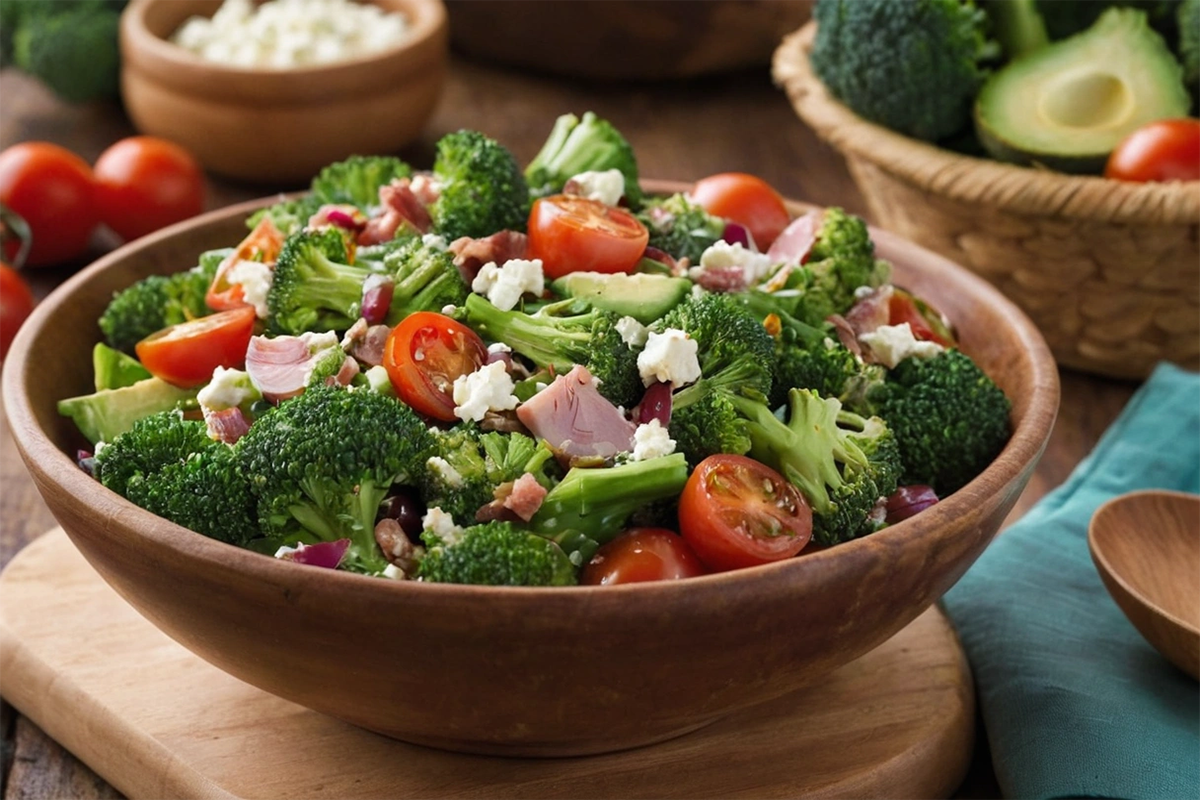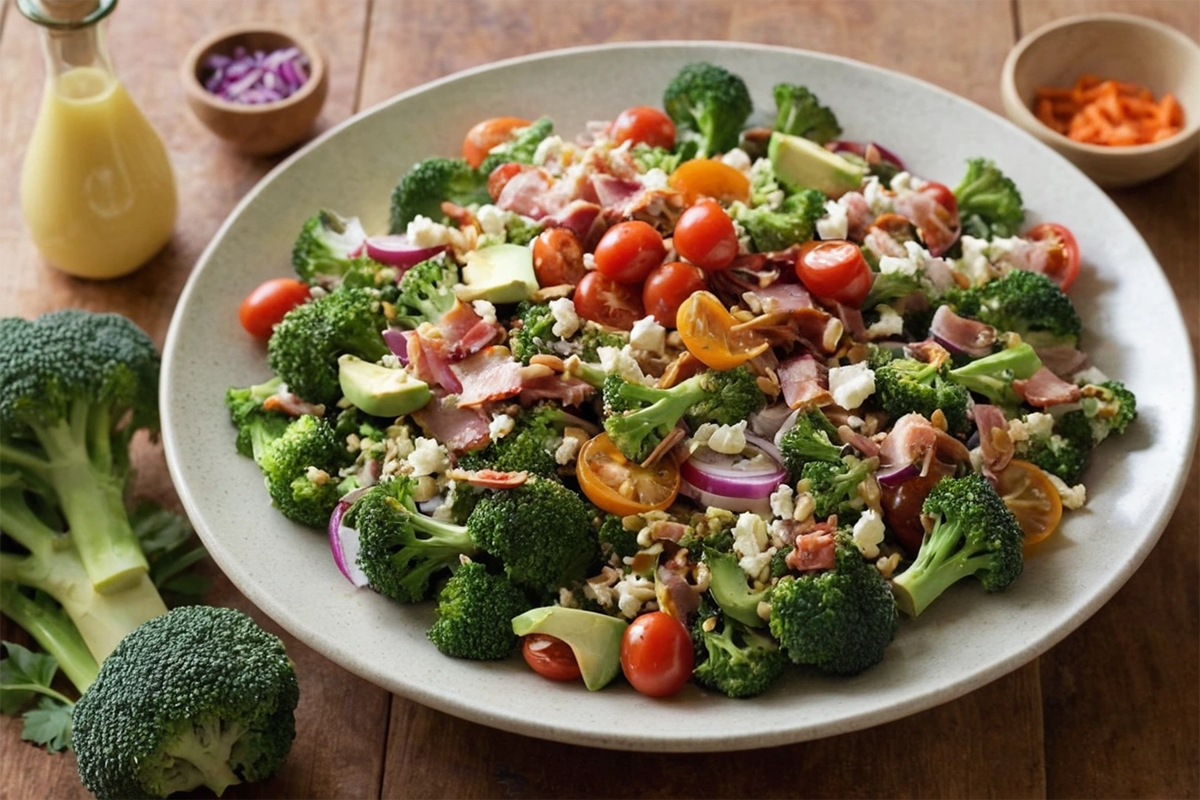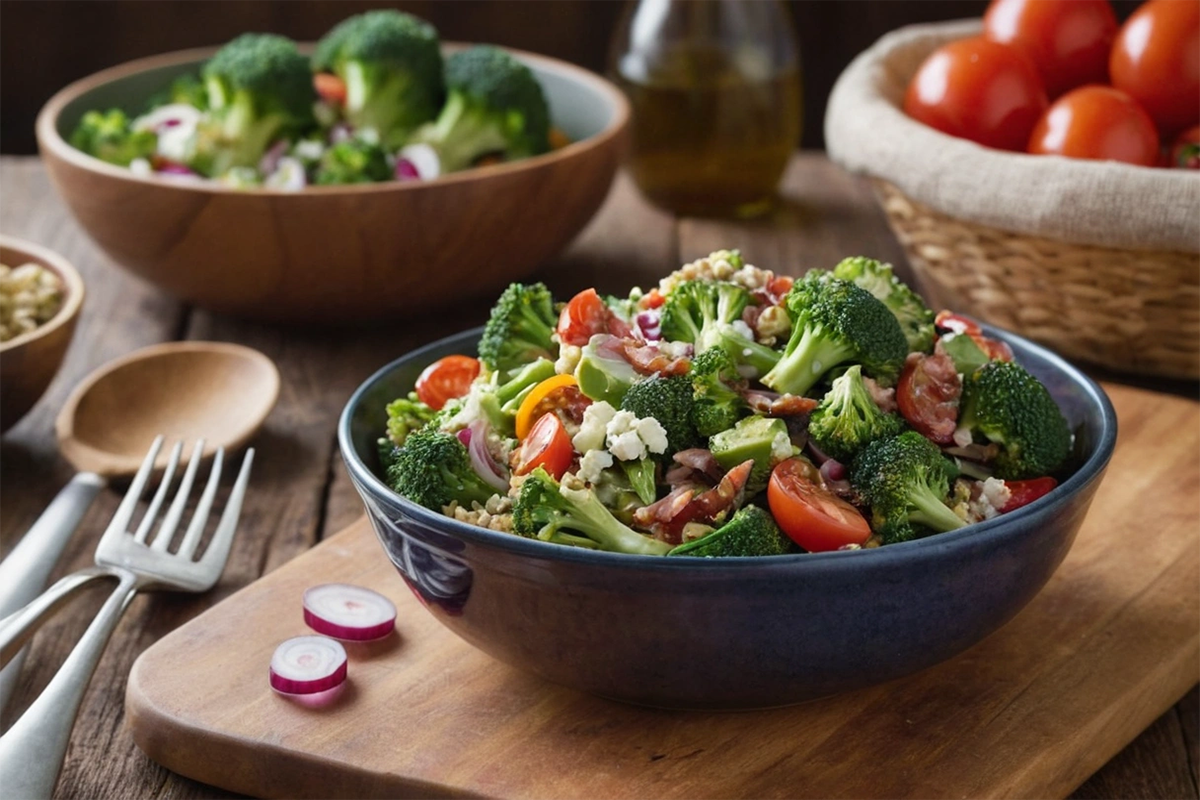Broccoli is one of the most popular vegetables around the world, loved for its high nutritional value and versatility in the kitchen. While most people are accustomed to steaming or roasting broccoli, a growing number of health enthusiasts prefer to eat it raw, especially in salads. But the question remains: “Can you eat broccoli raw in a salad?” The short answer is yes. Many find that eating broccoli raw in a salad is the best way to enjoy its crunch, freshness, and nutrient content.
In this article, we’ll delve into the nutritional benefits, potential downsides, and culinary uses of raw broccoli in salads. Whether you’re looking to get more raw vegetables in your diet or simply want to try a new salad ingredient, raw broccoli could be the perfect addition. Plus, we’ll give you tips on how to prepare it so that it tastes delicious.
Table of Contents
Nutritional Benefits of Eating Broccoli Raw
Packed with Vitamins, Minerals, and Antioxidants
Broccoli is considered a superfood due to its dense nutritional content. But can you eat broccoli raw in a salad to maximize these nutrients? The answer is yes. When consumed raw, broccoli retains its full spectrum of nutrients, making it a powerhouse for vitamins and minerals. Raw broccoli is especially rich in:
- Vitamin C: Known for boosting the immune system, vitamin C is abundant in raw broccoli. Just one cup of raw broccoli provides over 90% of the daily recommended intake.
- Vitamin K: Essential for bone health and proper blood clotting, raw broccoli delivers a generous amount of vitamin K, supporting heart and bone health.
- Folate: Critical for cell function, tissue growth, and preventing birth defects, folate is another key nutrient found in broccoli. This makes it particularly beneficial for pregnant women.
- Fiber: Broccoli is loaded with dietary fiber, which promotes digestive health, helps maintain a healthy gut, and assists in weight management by promoting satiety.
Additionally, broccoli contains sulforaphane, a plant compound found in cruciferous vegetables like broccoli and cauliflower, which researchers link to cancer prevention. This powerful compound supports the body’s natural detoxification processes and helps protect against oxidative stress. Eating broccoli raw ensures that these compounds remain intact, as cooking can reduce their levels.
Retaining Nutrients When Eaten Raw
One of the main reasons people choose to eat broccoli raw is to preserve its nutritional value. Cooking methods such as boiling or steaming can cause broccoli to lose some of its water-soluble vitamins, particularly vitamin C. When broccoli is consumed raw, none of these nutrients are lost.
Moreover, raw broccoli is high in glucosinolates, compounds that help detoxify the body and may have anticancer properties. Glucosinolates break down into active forms, such as sulforaphane, which have been shown to inhibit the development of cancer cells in some studies. Cooking can lower the levels of these beneficial compounds, so consuming broccoli raw ensures you get the maximum health benefits. If you’re interested in the nutritional advantages of raw broccoli, check out Healthline for more detailed insights.
Digestibility: Can Everyone Eat Broccoli Raw?
Fiber Content and Digestive Sensitivity
Broccoli’s high fiber content promotes digestive health. However, it can make raw broccoli harder to digest for some people. You might be wondering, can you eat broccoli raw in a salad every day? While it is highly nutritious, some people may find that the fiber content in raw broccoli can cause digestive discomfort. Since eating raw broccoli in a salad maintains its fiber structure, it might be harder to digest for individuals with sensitive stomachs.. Raw cruciferous vegetables, like broccoli, contain raffinose. This carbohydrate ferments in the gut and can cause digestive upset.
If you frequently experience bloating or discomfort after eating raw broccoli, it might be best to limit your intake or try blanching the vegetable before adding it to your salad. Blanching softens the tough fibers while retaining the crunch and most of the nutrients.
Soaking and Marinating to Improve Digestibility
For those who want to enjoy raw broccoli but are concerned about digestion, there are ways to make it more manageable:
- Marinating: Letting raw broccoli sit in a marinade made of olive oil, lemon juice, vinegar, and spices can soften the florets and make them easier to chew and digest. The acid in the lemon juice or vinegar breaks down the tough fibers and enhances the flavor. For optimal results, marinate the broccoli for at least 30 minutes before serving.
- Blanching: Blanching involves briefly boiling the broccoli for 1-2 minutes before plunging it into ice water to stop the cooking process. This technique retains the bright green color and crunch of the broccoli while making it easier to digest. Blanching is an excellent method if you want to enjoy a crunchy texture but find fully raw broccoli too tough.
Soaking or blanching is especially helpful for individuals who experience digestive distress but still want the nutritional benefits of raw broccoli.

Raw vs. Cooked: Nutritional Differences and Preferences
Cooking Methods and Nutrient Retention
Cooking broccoli has both benefits and drawbacks when it comes to nutrition. While boiling broccoli can result in the loss of water-soluble vitamins like vitamin C, steaming or stir-frying can actually help enhance the bioavailability of certain antioxidants and nutrients, such as beta-carotene and lutein. These compounds are important for eye health and reducing inflammation.
However, one of the major reasons to eat broccoli raw is the retention of its full vitamin C content, along with its fiber and antioxidant levels. If your goal is to maximize the intake of cancer-fighting compounds like sulforaphane, eating raw broccoli is the way to go.
From a flavor perspective, some people prefer the slightly bitter taste and crunchy texture of raw broccoli, especially when paired with salad dressings or seasonings that balance out the bitterness. Others may find raw broccoli too tough or fibrous and prefer the softer texture of cooked broccoli. It ultimately comes down to personal preference.
For those looking for a breakdown of the benefits and potential downsides of raw vs. cooked broccoli, check out the full article on EatingWell.
Can You Eat Broccoli Raw in a Salad? The Yes and No
The Benefits of Eating Raw Broccoli in Salads
Raw broccoli can be a wonderful addition to salads, offering a satisfying crunch and a fresh, earthy flavor. Its dense texture pairs well with other crunchy vegetables, fruits, seeds, and nuts. Additionally, the raw state preserves the maximum nutritional value of broccoli, providing an excellent source of vitamins C and K, fiber, and antioxidants.
Eating raw broccoli can also help support weight loss efforts, as its high fiber content promotes feelings of fullness, which may prevent overeating. The low-calorie profile of broccoli also makes it an ideal vegetable for anyone watching their caloric intake.
When Raw Broccoli Might Not Be the Best Option
Despite the numerous health benefits, raw broccoli isn’t for everyone. Some people might find the taste too bitter or the texture too fibrous. Additionally, individuals with digestive sensitivities might experience gas, bloating, or stomach discomfort when consuming raw broccoli.
If you’re not sure about raw broccoli’s effect on your digestion, start with small amounts and see how your body reacts. You can also try blanching or marinating the broccoli to soften its texture and make it easier to digest.
One simple trick to make raw broccoli more palatable is to marinate it in a mixture of lemon juice, olive oil, and salt. This not only enhances the flavor but also softens the tough fibers, making the broccoli more tender and easier to chew.
Raw Broccoli Salad Recipes and Preparation Techniques
Simple Raw Broccoli Salad Recipe
Here’s a delicious and easy recipe for a raw broccoli salad that you can enjoy as a side dish or a light lunch:
Ingredients:
- 2 cups raw broccoli florets
- 1/4 cup sliced almonds or sunflower seeds
- 1/2 cup dried cranberries or raisins
- 1/4 cup shredded carrots
- 1/4 cup red onion, finely chopped
- 2 tablespoons olive oil
- 1 tablespoon lemon juice or apple cider vinegar
- Salt and pepper to taste
Instructions:
- In a large mixing bowl, combine raw broccoli, almonds, cranberries, carrots, and red onion.
- In a small bowl, whisk together olive oil, lemon juice (or vinegar), salt, and pepper.
- Pour the dressing over the salad ingredients and toss well to ensure the broccoli is fully coated.
- Let the salad sit for 10-15 minutes before serving to allow the flavors to meld and the broccoli to soften slightly.
This raw broccoli salad is versatile. You can modify it by adding ingredients like feta cheese, avocado, or quinoa for extra protein and texture.
Techniques to Soften Raw Broccoli for Salads
There are several ways to prepare raw broccoli so that it fits perfectly in a salad:
- Blanching: As mentioned earlier, blanching involves briefly boiling the broccoli for 1-2 minutes and then cooling it in ice water. This helps retain the crunch while making it more digestible.
- Marinating: Let raw broccoli soak in a vinaigrette dressing for at least 30 minutes to soften the florets and infuse them with flavor.
- Chopping finely: Cutting the broccoli into smaller, bite-sized pieces can make it easier to chew and enjoy in a salad, especially for those who might find the texture of large florets overwhelming.
By using these methods, you can enjoy the best of both worlds. You get the crunch and nutrition of raw broccoli without the toughness or bitterness that might deter some people from eating it raw.

Frequently Asked Questions (FAQs)
Can I Eat Broccoli Raw Every Day?
Yes, you can eat raw broccoli every day, but it’s important to consume it in moderation. Since broccoli is high in fiber, eating too much raw broccoli may cause digestive issues. These issues can include bloating, gas, or constipation. To avoid discomfort, balance your diet with a mix of raw and cooked vegetables.
What Are the Risks of Eating Raw Broccoli?
The main risks involve potential digestive discomfort due to the high fiber content. Some people may experience bloating or gas after eating raw broccoli, especially if consumed in large quantities. Additionally, raw broccoli contains goitrogens, which can interfere with thyroid function in high amounts. However, eating moderate amounts of raw broccoli is generally safe for most people.
Does Eating Raw Broccoli Help with Weight Loss?
Absolutely! Raw broccoli is low in calories and high in fiber, making it an excellent addition to a weight-loss diet. The fiber content helps promote feelings of fullness, reducing the likelihood of overeating or snacking between meals.
How Can I Make Raw Broccoli Taste Better in Salads?
You can enhance the taste of raw broccoli by pairing it with flavorful ingredients. Try using lemon juice, olive oil, balsamic vinegar, or tahini. Adding a pinch of salt, pepper, or even a sprinkle of grated Parmesan cheese can elevate the flavor. You can also toss it with fruits like apples or dried cranberries for a touch of sweetness.
Conclusion: Can You Eat Broccoli Raw in a Salad?
In summary, adding raw broccoli to your salad is a fantastic way to enhance its nutritional content. Its crunchy texture and rich vitamins make it a versatile vegetable that can be enjoyed in many ways. Whether you prefer it raw for maximum nutrients or lightly cooked for better digestion, broccoli remains a superfood staple in healthy diets. If you’re looking for other ways to incorporate raw vegetables into your meals, you might also enjoy trying this Broccoli Crunch Salad, which offers a delicious take on raw broccoli. Additionally, for those interested in other nutritious and easy recipes, check out the Honey Butter Skillet Corn, another simple and healthy option.

